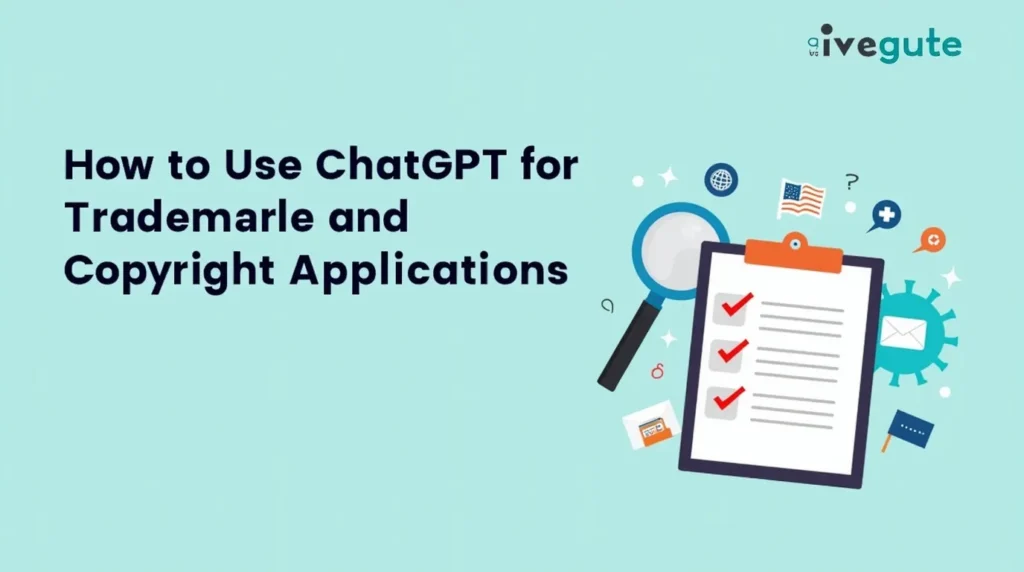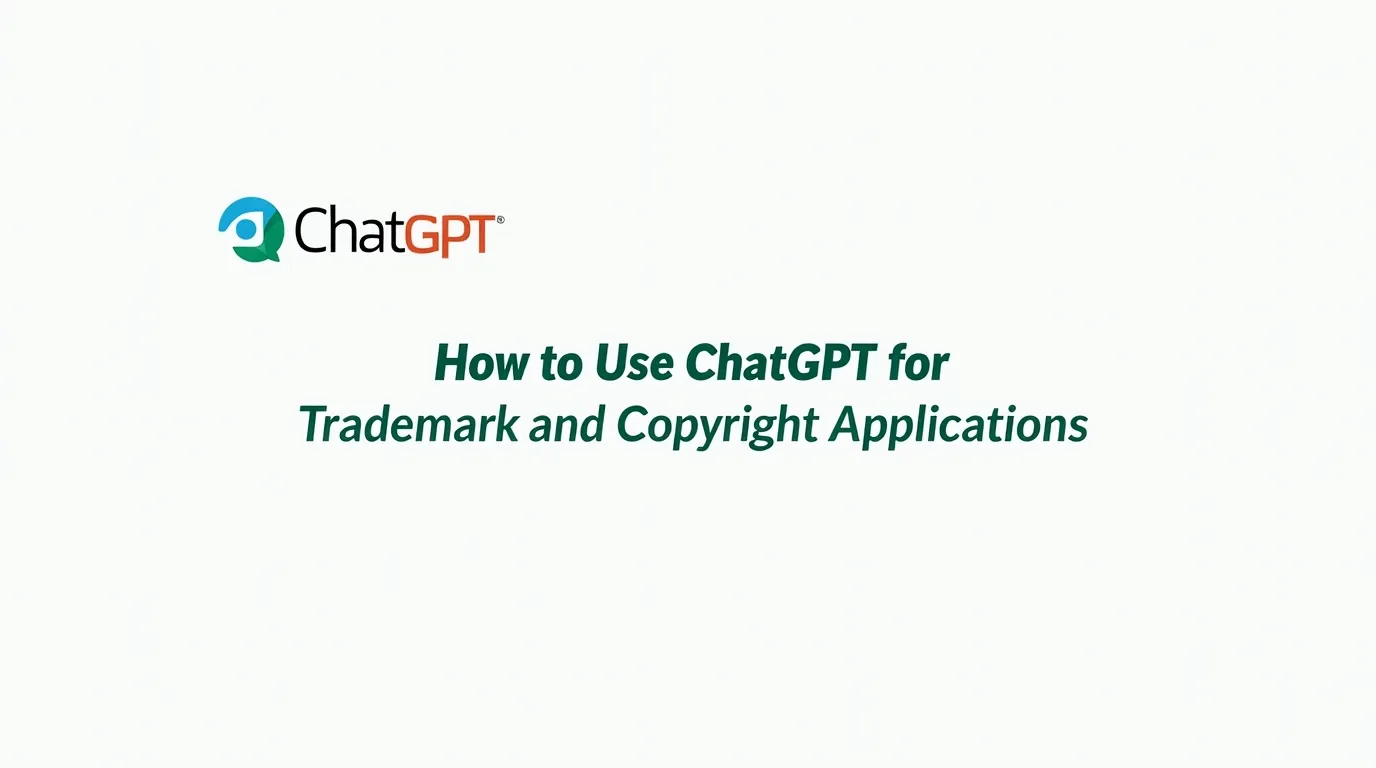Using ChatGPT for trademark and copyright applications has become increasingly popular among business owners and legal professionals. This comprehensive guide shows you exactly how to use AI tools for intellectual property filings while staying compliant with USPTO requirements.

What You Need to Know About ChatGPT and Intellectual Property
ChatGPT can help streamline your trademark and copyright application process, but it cannot replace professional legal expertise. Despite its enormous potential in internet search, ChatGPT is unable to get trademark drafting right, according to intellectual property experts.
Current USPTO Position on AI Tools
The USPTO publishes guidance informing practitioners and the public of the important issues that patent and trademark professionals, innovators, and entrepreneurs must navigate while using AI in matters before the USPTO.
Key points about AI usage:
- AI-generated content requires human oversight
- AI-generated images do not show actual use of a trademark in the marketplace and thus are considered misstatements of fact
- All AI-assisted work must be verified by qualified professionals
How ChatGPT Can Assist With Trademark Applications
Research and Initial Analysis
ChatGPT excels at preliminary trademark research tasks:
Trademark Classification Help
- Identify potential trademark classes for your goods or services
- Generate lists of related products or services
- Suggest alternative trademark descriptions
Market Research Support
- Analyze competitor trademark strategies
- Research industry-specific trademark trends
- Generate keyword lists for comprehensive searches
Document Preparation Assistance
While ChatGPT cannot file applications directly, it can help prepare supporting materials:
Description Writing
- Draft initial descriptions of goods and services
- Create consistent terminology across applications
- Generate multiple description variations for testing
Application Organization
- Structure supporting documentation
- Create checklists for required materials
- Generate timeline templates for application processes
Important Limitations
What ChatGPT Cannot Do:
- Conduct official trademark searches
- Guarantee application approval
- Replace qualified trademark attorneys
- File applications directly with USPTO
- Provide legal advice or guarantees
Using ChatGPT for Copyright Applications
Content Analysis and Documentation
ChatGPT can help organize your copyright materials:
Work Categorization
- Identify copyright categories for your creative works
- Generate detailed work descriptions
- Create comprehensive work inventories
Documentation Preparation
- Draft author statements and work histories
- Organize supporting materials chronologically
- Generate consistent filing terminology
Understanding AI-Generated Content Rights
As ChatGPT itself states, while the content generated may be protected by copyright, it will not be owned by the AI itself. Important considerations include:
- AI cannot own copyrights under current law
- Human authors retain rights to AI-assisted works
- Substantial human creativity must be present
- Part 2 was published on January 29, 2025, and addresses the copyrightability of outputs created using generative AI
Step-by-Step Process for Using ChatGPT
Phase 1: Initial Research
- Define Your Needs
- Specify trademark or copyright requirements
- Identify target markets and industries
- Determine application scope and priorities
- Use ChatGPT for Preliminary Research
- Generate keyword lists for searches
- Research similar marks or works
- Identify potential classification issues
- Organize Information
- Create structured data sheets
- Document research findings
- Prepare preliminary application outlines
Phase 2: Content Development
- Draft Supporting Materials
- Use ChatGPT to write initial descriptions
- Generate multiple content variations
- Create consistent terminology guides
- Review and Refine
- Verify all AI-generated content
- Ensure accuracy and completeness
- Check for potential legal issues
- Professional Validation
- Submit drafts to qualified attorneys
- Incorporate professional feedback
- Finalize application materials
Best Practices and Compliance
Quality Control Measures
Always Verify AI Output:
- Cross-reference all facts and legal requirements
- Confirm classification accuracy
- Validate market research findings
- Check for potential conflicts or issues
Professional Oversight:
- Consult qualified IP attorneys for complex matters
- Use licensed trademark and copyright professionals
- Maintain proper legal documentation
- Follow all USPTO and Copyright Office requirements
Common Mistakes to Avoid
Application Errors:
- Relying solely on AI-generated searches
- Submitting unverified information
- Misclassifying goods or services
- Using inappropriate AI-generated evidence
Legal Compliance Issues:
- Ignoring professional legal advice
- Missing required disclosures
- Submitting inaccurate statements
- Failing to meet filing deadlines
Tools and Resources for Enhanced Results
Recommended AI Prompts for Trademark Work
Research Prompts:
- “Analyze trademark classifications for [product/service]”
- “Generate alternative descriptions for [trademark]”
- “Identify potential trademark conflicts in [industry]”
Documentation Prompts:
- “Create comprehensive goods and services descriptions”
- “Generate trademark use evidence templates”
- “Draft initial application summaries”
Copyright-Specific Prompts
Content Analysis:
- “Categorize creative works for copyright registration”
- “Generate detailed work descriptions for applications”
- “Create copyright portfolio organization systems”
Documentation Support:
- “Draft author contribution statements”
- “Generate work creation timelines”
- “Create copyright notice templates”
Cost Considerations and ROI
Potential Savings
Using ChatGPT can reduce costs through:
- Faster preliminary research
- Improved document organization
- Reduced attorney consultation time
- Better application preparation
Investment Requirements
Direct Costs:
- ChatGPT subscription fees
- Professional review services
- USPTO and Copyright Office fees
- The USPTO is increasing the filing fee for in-bound filings under Section 66(a) from $500/class to $600/class
Time Investment:
- Learning AI tool capabilities
- Developing effective prompts
- Quality control and verification
- Professional consultation coordination
Future Developments and Updates
Evolving AI Capabilities
The landscape continues changing rapidly:
- On January 14, 2025, the USPTO released its Artificial Intelligence Strategy, providing a structured approach to integrating AI into patent and trademark examination
- New AI tools and features regularly emerge
- USPTO policies continue evolving
- Copyright Office guidance updates frequently
Staying Current
Monitor These Sources:
- USPTO official announcements and guidance
- Copyright Office policy updates
- Professional IP organization publications
- AI tool feature updates and limitations
Final Thoughts
ChatGPT can significantly improve your trademark and copyright application process when used correctly. The key lies in understanding its capabilities and limitations while maintaining proper legal oversight.
Remember that AI tools are assistants, not replacements for qualified legal professionals. Use ChatGPT to enhance your research, organization, and preparation, but always verify results through professional channels.
